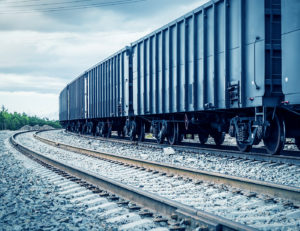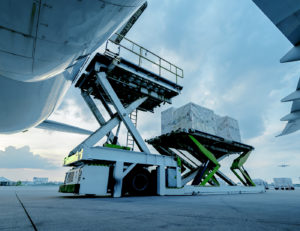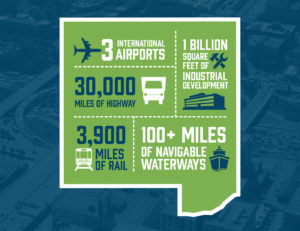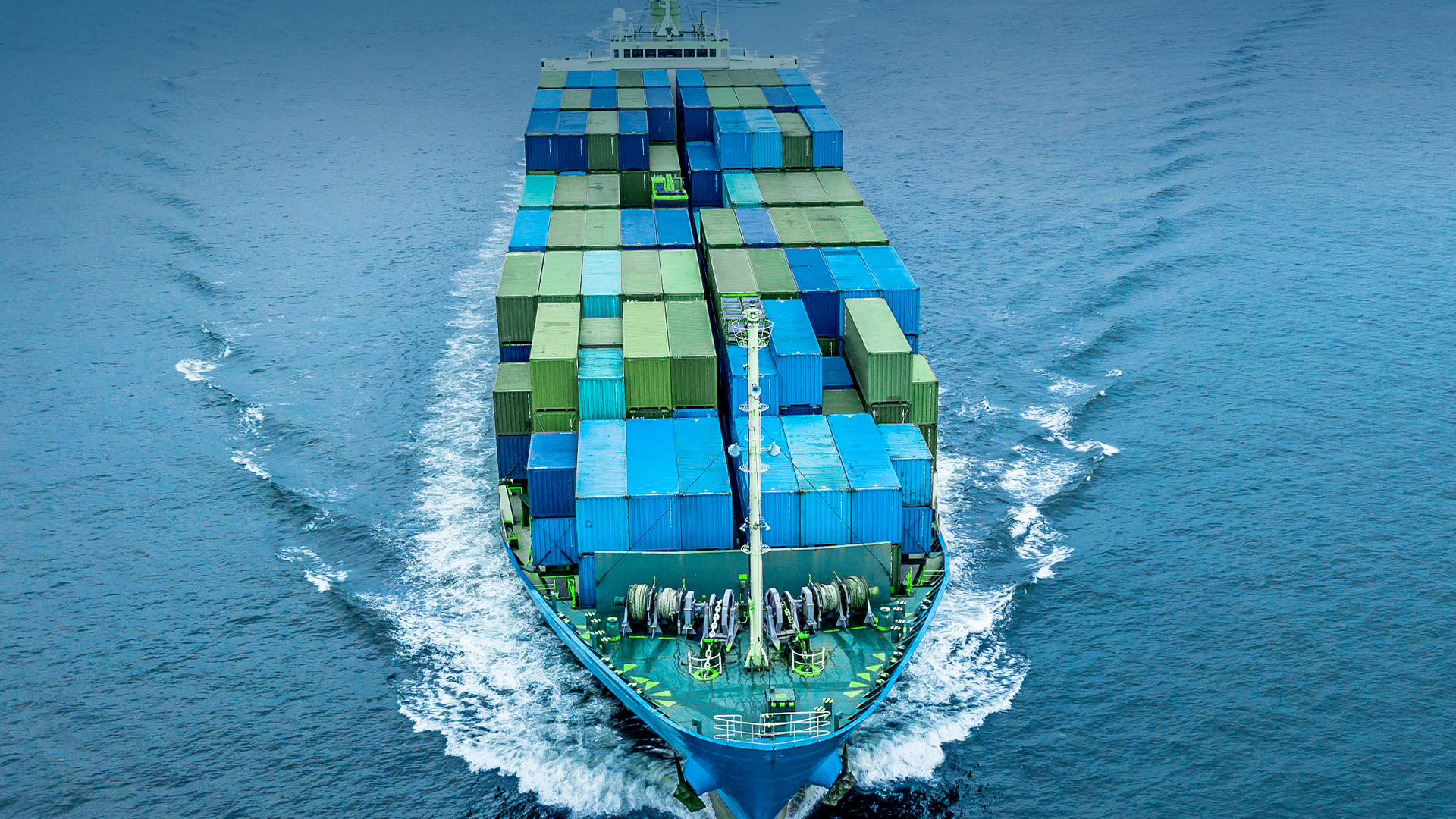As the economic aftershocks of COVID-19 reverberate through the global economy, transportation and logistics operations face mounting pressure to meet consumer demand, deliver essential goods and find cost-effective solutions. Meanwhile, these companies must contend with an uncertain future and a volatile market, where demand in some sectors skyrockets even as it plummets in others.
Now, transportation and logistics businesses are rethinking where and how they operate, and many are finding a home that offers the strategic advantages they need at the heart of the United States’ transportation infrastructure.
A Perfect Storm: The Pandemic Complicates an Already-Stressed Supply Chain
Before COVID-19, global demand on the supply chain was rising for decades, fueled by the rapidly growing e-commerce sector, rising populations, advances in technology, changing consumer and business preferences, and increases in standards of living, among other factors.
Take the U.S., for example. Since 1998, the country’s e-commerce sector has grown, often exponentially, year over year. As a result, U.S. intermodal volume – the total volume of standardized shipping containers that can be interchanged between multiple transportation modes, like cargo ships and freight trains – increased by more than 170%. This led to a boom in industrial development, as new warehouses, manufacturing facilities, ports, cargo centers, railways and other infrastructures were built to support the growing industry. In addition to the increase in volume, e-commerce conditioned consumers to expect deliveries in less time, presenting the industry with a dual challenge: Move more, and move faster.
This trend is not unique to the United States. During the same period, developed nations throughout the world experienced similar growth in e-commerce and other sectors, and previously undeveloped countries began to join them. As nations like China continued to develop – and more consumers, with increased spending power, participated in e-commerce – sharp increases in demand followed, in a pattern of economic growth, increased demand and further growth. Analysts expect this trend to intensify over the coming decade, even as the global economy faces the economic fallout of the pandemic and the transportation and logistics industry contends with emerging challenges.
COVID-19 has led to a devastating loss of human life. Meanwhile, its economic aftershocks have created unprecedented volatility within the transportation and logistics industry, with some sectors experiencing spikes in demand even as others plummet. For example, at the beginning of 2020, truck volumes surged by nearly 30 percent, and last-mile deliveries increased more than ten times over. However, as the GDP plummeted by a historic 32.9% in the second quarter, truck volumes fell with it, and other modes of transportation saw even steeper declines. U.S. passenger air travel – which is responsible for moving people as well as cargo, as goods are transported in the belly of passenger aircraft – fell by about 75% from the beginning of the year to April.
Now, as some sectors begin to see a resurgence in demand and certain transportation modes become available, businesses are discovering that the nature of their industry is changing.
<
An Answer to the Challenge
The combined pressures of the decades-long increase in global demand and the volatility brought on by the pandemic has forced transportation and logistics operations to become more flexible, efficient and cost-effective. Consumer demand is expected to rise exponentially in the coming decade, and several emergent factors – such as the rapid and reliable delivery of medical supplies and other essential goods (including vaccines, in the near future) – further stress the supply chain.
The industry is facing unprecedented challenges, at a time when it is interwoven in nearly every function of human life and society. Families, communities and economies throughout the world depend on supply chains that can deliver—especially in times of crisis.
To continue to meet consumer demand, businesses must locate their operations in a place that answers the complex challenges they face today and positions them to meet the demands of tomorrow.
Now, many of these companies are finding the strategic advantages they need in DuPage County. DuPage is located just west of Chicago, at the heart of an international freight gateway, offering convenient access to the region’s multiple transportation modes, as well as key advantages unique to DuPage.
Let’s take a closer look.
Where Water Meets Road, Rail and Sky: The Strategic Location of DuPage County
Located at the convergence of critical waterways, interstates, airports and railways, Northeastern Illinois is considered by many to be North America’s preeminent international freight gateway. Today, one fourth of all U.S. freight originates, terminates, or passes through the region. That’s approximately $564 billion in goods each year, weighing some 269 million tons, and includes half of the nation’s rail freight and nearly one-third of its air cargo.
The region is a critical link in the national and global supply chain, and its access to multi-modal transportation means that, when an area of the transportation infrastructure is disrupted – as we have seen during COVID-19 – operations in the region can continue to move products through other modes. The region’s flexibility is key to the transportation and logistics industry’s ability to deliver essential goods in times of crisis. For example, when passenger air travel dipped by 75% in the U.S. at the peak in the pandemic, the cargo typically transported by passenger flights could be averted to other transportation modes, like waterways and rail. Of course, that can only be done quickly and efficiently if operations have convenient access to multiple modes of transportation, as they do in DuPage County and the surrounding region.
Clearly, the Northeastern Illinois region has a tremendous economic impact on the Midwest and the entire U.S.—as well as countries, companies and people throughout the world. In the aftermath of COVID-19, the area including DuPage County has an essential role in strengthening and re-imagining the nation’s supply chain, offering multiple transportation modes and providing a strategic, flexible and cost-effective home for businesses.

Regional Highlights:
- As mentioned above, operations in the region have access to multiple modes of transportation. This allows for more flexibility and efficiency in all times—however, it’s particularly important during times of crisis. When certain modes of transportation are disrupted, operations in the region can continue to move goods, including essential supplies, via other transportation modes. The region’s access to multiple transportation modes – via water, rail, road and sky – makes it a critical link in the global supply chain.
- Located 40 miles from Chicago, the CenterPoint Intermodal Center, North America’s largest inland port, provides direct access to the BNSF Logistics Park and Union Pacific Intermodal Terminal, as well as a 6,400-acre intermodal complex. Tenants, on average, save 50% on operating costs due to the transportation savings of locating on campus.
- The Port of Chicago offers the only direct maritime connection from the Great Lakes to the Atlantic Ocean via the Mississippi River. Today, more than 19 million tons of goods are moved through the port.
- The region offers access to more than a thousand miles of navigable waterways throughout Illinois, with more than 100 miles of navigable waterways within the Northeast.
- Northeastern Illinois is home to three international airports: O’Hare, Midway and the DuPage Airport. O’Hare is responsible for moving nearly one third of the nation’s total cargo, valued at $170 billion annually. With infrastructure improvements over the coming decades, O’Hare’s cargo campus will allow up to 50% more cargo and freight traffic.
- Seven interstates and some 30,000 miles of highways connect operations in the region to cities throughout the Midwest and the entire continental U.S. In less than eight hours, trucks can travel from Northeastern Illinois to 28 of the top 30 cities in the Midwest.
- The region is home to one of the nation’s busiest rail gateways, with more than 3,900 miles of rail. The gateway is North America’s main interchange point between western and eastern railroads. Today, 50% of all U.S. rail freight passes through the region, which offers freight access to more than 80% of the continental United States in 72 hours or less.
- Northeastern Illinois accounts for about half of all domestic intermodal container traffic.
- More than a billion square feet of industrial development support the region’s freight and manufacturing activity.

The DuPage Difference
While Northeastern Illinois is home to seven counties, DuPage County offers unique strategic advantages that make it the premier choice for the transportation and logistics industry.
Just 20 miles west of Chicago, DuPage offers convenient access to all of the regional transportation amenities described above, including North America’s largest inland port, three international airports, seven interstates, the nation’s busiest rail gateway, and more. In addition, DuPage offers unique strategic advantages for businesses.

The DuPage Difference:
- A strategic location just 20 miles west of Chicago, DuPage offers convenient access to the region’s international transportation infrastructure, as described above.
- DuPage is home to 127 square miles of prime real estate that will soon offer direct access to O’Hare through the region’s Western Access initiative.
- Local businesses benefit from a business-friendly climate with low commercial property taxes and a highly skilled and educated workforce.
- Our residents enjoy a high quality of life, with easy commutes, excellent schools, numerous recreational amenities and more space for work and life.
- DuPage County’s highly desirable commercial properties offer space for large industrial facilities and flexible leases.
- Our collaborative local leadership is committed to the success of your business and our communities.
In a challenging and uncertain time, DuPage County offers businesses a strategic home, where they can quickly and efficiently get their goods to market through the region’s access to multiple transportation modes, while benefitting from DuPage’s unique advantages and business-friendly climate.
We all depend on transportation and logistics operations for the goods we need, as well as the health of the national and global economy. DuPage provides the comprehensive solution that these operations need to be cost-effective, flexible and efficient, so the industry can continue to meet the demands of today as we work together toward a better tomorrow.
Click or tap here to learn more about transportation, logistics and warehousing in DuPage County.
Sources:
Statista
Chicago Metropolitan Agency for Planning (CMAP)
“CenterPoint offering timely cost savings with North America’s largest inland port” by Paul Scott Abbott, American Journal of Transportation (2020)


